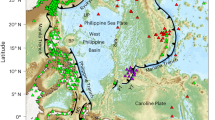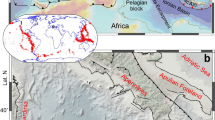Abstract
The lowermost part of the Earth’s mantle—known as D″—shows significant seismic anisotropy, the variation of seismic wave speed with direction1,2,3,4,5. This is probably due to deformation-induced alignment of MgSiO3-post-perovskite (ppv), which is believed to be the main mineral phase present in the region. If this is the case, then previous measurements of D″ anisotropy, which are generally made in one direction only, are insufficient to distinguish candidate mechanisms of slip in ppv because the mineral is orthorhombic. Here we measure anisotropy in D″ beneath North and Central America, where material from subducting oceanic slabs impinges6 on the core–mantle boundary, using shallow as well as deep earthquakes to increase the azimuthal coverage in D″. We make more than 700 individual measurements of shear wave splitting in D″ in three regions from two different azimuths in each case. We show that the previously assumed2,3,7 case of vertical transverse isotropy (where wave speed shows no azimuthal variation) is not possible, and that more complicated mechanisms must be involved. We test the fit of different MgSiO3-ppv deformation mechanisms to our results and find that shear on (001) is most consistent with observations and the expected shear above the core–mantle boundary beneath subduction zones. With new models of mantle flow, or improved experimental determination of the dominant ppv slip systems, this method will allow us to map deformation at the core–mantle boundary and link processes in D″, such as plume initiation, to the rest of the mantle.
This is a preview of subscription content, access via your institution
Access options
Subscribe to this journal
Receive 51 print issues and online access
$199.00 per year
only $3.90 per issue
Buy this article
- Purchase on Springer Link
- Instant access to full article PDF
Prices may be subject to local taxes which are calculated during checkout



Similar content being viewed by others
References
Kendall, J.-M. & Silver, P. Constraints from seismic anisotropy on the nature of the lowermost mantle. Nature 381, 409–412 (1996)
Kendall, J.-M. & Silver, P. G. in The Core–Mantle Boundary Region (eds Gurnis, M., Wysession, M. E., Knittle, E. & Buffett, B. A.) 97–118 (American Geophysical Union, 1998)
Lay, T., Williams, Q., Garnero, E. J., Kellogg, L. & Wysession, M. E. in The Core–Mantle Boundary Region (eds Gurnis, M., Wysession, M. E., Knittle, E. & Buffett, B. A.) 299–318 (American Geophysical Union, 1998)
Maupin, V., Garnero, E. J., Lay, T. & Fouch, M. J. Azimuthal anisotropy in the D″ layer beneath the Caribbean. J. Geophys. Res. Solid Earth 110, B08301 (2005)
Long, M. D. Complex anisotropy in D″ beneath the eastern Pacific from SKS–SKKS splitting discrepancies. Earth Planet. Sci. Lett. 283, 181–189 (2009)
Ren, Y., Stutzman, E., van der Hilst, R. D. & Besse, J. Understanding seismic heterogeneities in the lower mantle beneath the Americas from seismic tomography and plate tectonic history. J. Geophys. Res. Solid Earth 112, B01302 (2007)
Kendall, J.-M. & Nangini, C. Lateral variations in D″ below the Caribbean. Geophys. Res. Lett. 23, 399–402 (1996)
Garnero, E. J., Maupin, V., Lay, T. & Fouch, M. J. Variable azimuthal anisotropy in Earth’s lowermost mantle. Science 306, 259–261 (2004)
Rokosky, J. M., Lay, T. & Garnero, E. J. Small-scale lateral variations in azimuthally anisotropic D″ structure beneath the Cocos plate. Earth Planet. Sci. Lett. 248, 411–425 (2006)
Wookey, J. & Kendall, J.-M. Constraints on lowermost mantle mineralogy and fabric beneath Siberia from seismic anisotropy. Earth Planet. Sci. Lett. 275, 32–42 (2008)
Wookey, J., Kendall, J.-M. & Rumpker, G. Lowermost mantle anisotropy beneath the north Pacific from differential S–ScS splitting. Geophys. J. Int. 161, 829–838 (2005)
Meade, C., Silver, P. & Kaneshima, S. Laboratory and seismological observations of lower mantle isotropy. Geophys. Res. Lett. 22, 1293–1296 (1995)
Karki, B., Wentzcovitch, R., de Gironcoli, S. & Baroni, S. First-principles determination of elastic anisotropy and wave velocities of MgO at lower mantle conditions. Science 286, 1705–1707 (1999)
Long, M. D., Xiao, X., Jiang, Z., Evans, B. & Karato, S. Lattice preferred orientation in deformed polycrystalline (Mg,Fe)O and implications for seismic anisotropy in D″. Phys. Earth Planet. Inter. 156, 75–88 (2006)
Yamazaki, D. & Karato, S. Fabric development in (Mg,Fe)O during large strain, shear deformation: implications for seismic anisotropy in Earth’s lower mantle. Phys. Earth Planet. Inter. 131, 251–267 (2002)
Merkel, S. et al. Deformation of (Mg,Fe)SiO3 post-perovskite and D″ anisotropy. Science 316, 1729–1732 (2007)
Merkel, S. et al. Plastic deformation of MgGeO3 post-perovskite at lower mantle pressures. Science 311, 644–646 (2006)
Oganov, A., Martonak, R., Laio, A., Raiteri, P. & Parrinello, M. Anisotropy of Earth’s D″ layer and stacking faults in the MgSiO3 post-perovskite phase. Nature 438, 1142–1144 (2005)
Carrez, P., Ferré, D. & Cordier, P. Implications for plastic flow in the deep mantle from modelling dislocations in MgSiO3 minerals. Nature 446, 68–70 (2007)
Yamazaki, D., Yoshino, T., Ohfuji, H., Ando, J. & Yoneda, A. Origin of seismic anisotropy in the D″ layer inferred from shear deformation experiments on post-perovskite phase. Earth Planet. Sci. Lett. 252, 372–378 (2006)
Iitaka, T., Hirose, K., Kawamura, K. & Murakami, M. The elasticity of the MgSiO3 post-perovskite phase in the Earth’s lowermost mantle. Nature 430, 442–445 (2004)
Okada, T., Yagi, T., Niwa, K. & Kikegawa, T. Lattice-preferred orientations in post-perovskite-type MgGeO3 formed by transformations from different pre-phases. Phys. Earth Planet. Inter. 180, 195–202 (2010)
Stackhouse, S., Brodholt, J. P., Wookey, J., Kendall, J.-M. & Price, G. D. The effect of temperature on the seismic anisotropy of the perovskite and post-perovskite polymorphs of MgSiO3 . Earth Planet. Sci. Lett. 230, 1–10 (2005)
Tsuchiya, T., Tsuchiya, J., Umemoto, K. & Wentzcovitch, R. Phase transition in MgSiO3 perovskite in the Earth’s lower mantle. Earth Planet. Sci. Lett. 224, 241–248 (2004)
Wookey, J., Stackhouse, S., Kendall, J.-M., Brodholt, J. P. & Price, G. D. Efficacy of the post-perovskite phase as an explanation for lowermost-mantle seismic properties. Nature 438, 1004–1007 (2005)
Wookey, J. & Kendall, J.-M. in Post-Perovksite: The Last Mantle Phase Transition (eds Hirose, K., Brodholt, J., Lay, T. & Yuen, D.) 171–189 (American Geophysical Union, 2007)
Wentzcovitch, R., Tsuchiya, T. & Tsuchiya, J. MgSiO3 postperovskite at D″ conditions. Proc. Natl Acad. Sci. USA 103, 543–546 (2006)
Blackman, D. et al. Teleseismic imaging of subaxial flow at mid-ocean ridges: traveltime effects of anisotropic mineral texture in the mantle. Geophys. J. Int. 127, 415–426 (1996)
McNamara, A., van Keken, P. & Karato, S. Development of finite strain in the convecting lower mantle and its implications for seismic anisotropy. J. Geophys. Res. Solid Earth 108, 2230 (2003)
Ritsema, J., van Heijst, H. J. & Woodhouse, J. H. Complex shear wave velocity structure imaged beneath Africa and Iceland. Science 286, 1925–1928 (1999)
Evans, M., Kendall, J.-M. & Willemann, R. Automated SKS splitting and upper-mantle anisotropy beneath Canadian seismic stations. Geophys. J. Int. 165, 931–942 (2006)
Wuestefeld, A., Bokelmann, G., Barruol, G. & Montagner, J.-P. Identifying global seismic anisotropy patterns by correlating shear-wave splitting and surface-wave data. Phys. Earth Planet. Inter. 176, 198–212 (2009)
Silver, P. & Chan, W. W. Shear-wave splitting and subcontinental mantle deformation. J. Geophys. Res. Solid Earth 96, 16429–16454 (1991)
Wolfe, C. & Silver, P. Seismic anisotropy of oceanic upper mantle: Shear wave splitting methodologies and observations. J. Geophys. Res. Solid Earth 103, 749–771 (1998)
Teanby, N., Kendall, J. M. & der Baan, M. V. Automation of shear-wave splitting measurements using cluster analysis. Bull. Seismol. Soc. Am. 94, 453–463 (2004)
Frederiksen, A. W. et al. Lithospheric variations across the Superior Province, Ontario, Canada: evidence from tomography and shear wave splitting. J. Geophys. Res. Solid Earth 112, B07318 (2007)
Wolfe, C. & Solomon, S. Shear-wave splitting and implications for mantle flow beneath the MELT region of the East Pacific Rise. Science 280, 1230–1232 (1998)
Acknowledgements
We thank J. Brodholt and D. Dobson for comments. A.N. was supported by NERC. Seismic data were provided by I. Bastow, D. Thompson, and the IRIS and CNSN data centres.
Author information
Authors and Affiliations
Contributions
A.N. analysed the data and produced the manuscript and figures. J.W. wrote the analysis and modelling code and performed the modelling. J.W. and J-M.K. supervised the analysis and commented on the manuscript and figures. All authors discussed the results and implications at all stages.
Corresponding author
Ethics declarations
Competing interests
The authors declare no competing financial interests.
Supplementary information
Supplementary Information
This file contains Supplementary Results and Discussion, Supplementary Figures 1-14 with legends, Supplementary Tables 1-6 and additional references. (PDF 6965 kb)
Rights and permissions
About this article
Cite this article
Nowacki, A., Wookey, J. & Kendall, JM. Deformation of the lowermost mantle from seismic anisotropy. Nature 467, 1091–1094 (2010). https://doi.org/10.1038/nature09507
Received:
Accepted:
Published:
Issue Date:
DOI: https://doi.org/10.1038/nature09507
This article is cited by
-
Ultralow velocity zone and deep mantle flow beneath the Himalayas linked to subducted slab
Nature Geoscience (2024)
-
Seismic anisotropy of the D″ layer induced by (001) deformation of post-perovskite
Nature Communications (2017)
-
Prediction of Mechanical Twinning in Magnesium Silicate Post-Perovskite
Scientific Reports (2017)
-
Strong inheritance of texture between perovskite and post-perovskite in the D′′ layer
Nature Geoscience (2013)
-
Mantle fabric unravelled?
Nature Geoscience (2013)
Comments
By submitting a comment you agree to abide by our Terms and Community Guidelines. If you find something abusive or that does not comply with our terms or guidelines please flag it as inappropriate.



